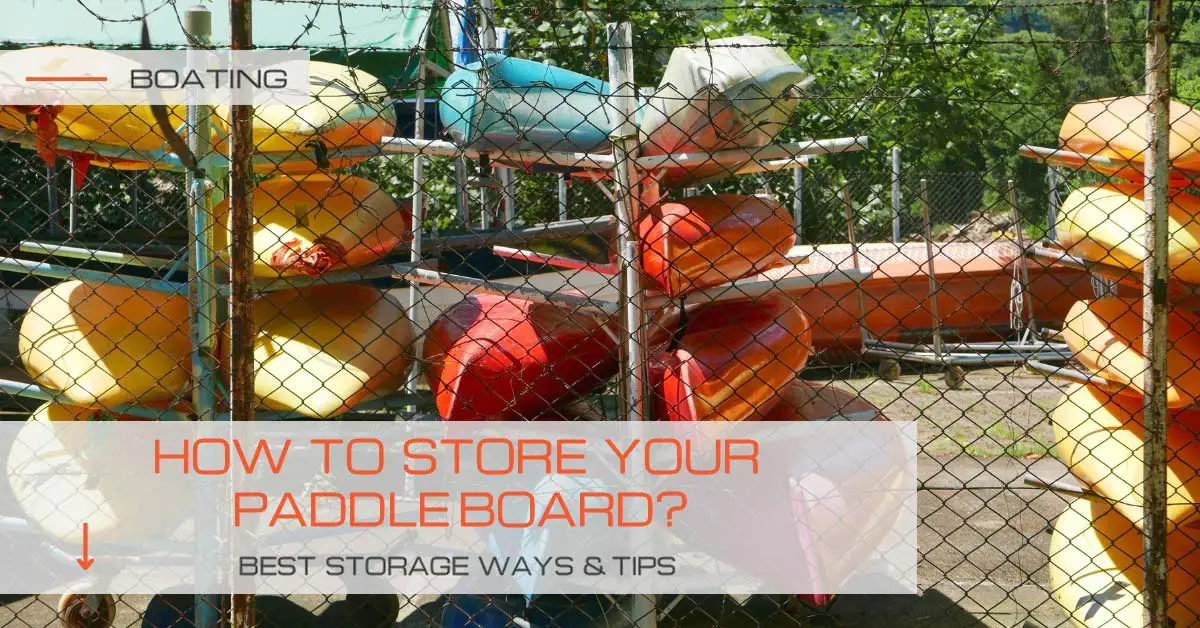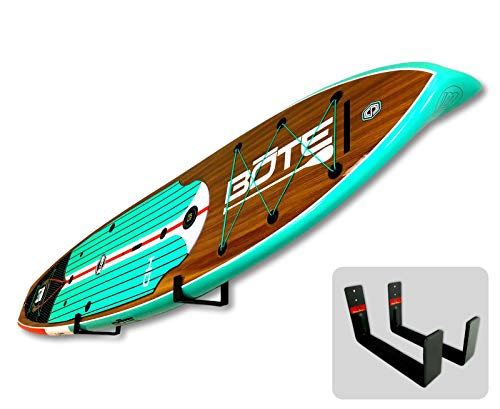Paddleboarding and kayaking are very good sports activities on the water. It gives immense pleasure, energy, and happiness and keeps you fit and healthy. However, unfortunately, the pleasure of paddleboarding is limited to a few weeks of warm weather for most of us, and you have no alternative but to wait for the next warm season.
But what about the paddleboard? One major difficulty faced by the owners of paddleboards is safely storing the paddleboard during the harsh winter days. If you want your paddleboard in a fit condition for your adventure in the next warm season, it is worth taking some trouble to store your paddleboard properly.
You may have heard many stories from your parents, relatives, or friends about how a paddleboard was damaged due to improper storage. We need to learn from others’ experiences too. You may wonder why you have not gone for an inflatable paddleboard. An inflatable paddleboard does not solve your storage problem completely since even an ISUP needs storage during winter.
Proper storing of the paddleboards will improve their lifespan, and you can look forward to having a wonderful time on the water year after year.
You have spent a good amount of dollars on a solid paddleboard, and even the inflatable paddleboard does not come cheap. So, whether you own a solid paddleboard or an inflatable paddleboard, it is essential to take storage precautions. We shall discuss and understand the solutions available for storing solid and inflatable paddleboards.
How to store your solid paddleboard?
You have to take many precautions before storing your paddleboard, and they are:
Clean the paddleboard:
- Give the paddleboard a freshwater wash with mild soap, wash away all the dirt, and make it clean.
- Wipe the paddleboard dry with a clean and dry cloth (a towel can be used).
- Do not dry it under the sun; sunlight can harm the paddleboard.
No direct sunlight: Ensure your paddleboard is protected from direct sunlight. Ultraviolet rays can damage the shell and its color.
No water or moisture: Protect your paddleboard from moisture and water. Never store the paddleboard on the floor or touch the floor. Moisture can cause fungal growth.
No extreme temperatures: Ensure your paddleboard is not subjected to extreme hot or cold temperatures.
Proper weight distribution: Distributing the weight of the paddleboard evenly is important when storing it. Uneven weight distribution can cause deformation. Also, ensure the support points have padding on them.
Protection from theft: This can be an issue if you store your paddleboard outside. If you feel theft can be an issue, safeguard your paddleboard with a simple locking system.
Where to store your paddleboards?
Your solid paddleboard may have a length of 10/12 feet or more and weigh 20 or more pounds, and you may have more than one paddleboard. The storage of your paddleboard needs some planning. And the first issue you have to decide on is the location of the storage.
The storage location can be indoor (normally the garage) or outdoor. In exceptional cases, if your paddleboard looks great and artistic, you may be willing to accommodate it on your living room or bedroom wall.
1. Storing your paddleboard inside your living room or bedroom
Your living room is an ideal place for storing your SUP or ISUP. The dry and controlled ambiance protects the SUP/ISUP from heat, cold, and moisture. Select a paddleboard with an attractive design, and select a rack that showcases the paddleboard on the wall. This way, you are safely storing your paddleboard and, at the same time, adding art to your wall. Select a wall that does not get direct sunlight.
Following are a few popular paddleboard indoor storage ideas:
But the inside space is precious, and the paddleboard can be the last priority on your list of items to be accommodated. The next preferred location is your garage.
2. Storing your paddleboard inside the garage
A garage is a good place to store your paddleboards. It is completely covered, and there is no direct sunlight. Also, it has a stable temperature. You can design your rack or purchase the rack online to store your paddleboards safely and away from the floor. You have many options for storing the paddleboards, and these options can use the space on the wall, ceiling, or floor space. You can install wall mounting racks, ceiling racks, or free-standing racks on the floor.
Ensure the weight distribution is even when storing the paddleboard on the rack. Uneven distribution of weight can result in deformation. This is important for inflatable paddleboards also. When you are strapping the paddleboard, ensure it is not tight. There should be space for movement, and a too-tight strap can deform a paddleboard gradually.
Wall-mounted racks: Paddleboard racks are convenient for storing paddleboards, and you have multiple options to store more than one paddleboard in a single rack. The construction of the rack allows you to store the paddleboard with the fins.
You can do your own racks (DIY) or order a suitable one online. Use felt or any smooth padding on the rack to avoid damage to the paddleboard. Normally the racks provide support on the edges of the paddleboard, and on such racks, place the paddleboard with its top surface or deck (where you stand) facing upwards. Remove the fins if they are removable.
Ensure that the weight of the paddleboard is evenly distributed and follow the owner’s manual instructions for maintaining the space between the two arms of the rack. The wrong distribution of the weight may lead to deformation. Do not place one paddleboard over another.
Following are a few popular paddleboard wall rack storage:
Suspended from the ceiling: If you do not have space on the garage wall, you can choose to utilize your garage ceiling space for paddleboard storage. It may be safe to remove the fins from the paddleboard. One problem you may face is lifting the paddleboard and bringing it down whenever you want to store or take it out. A ceiling storage system with rope and a pulley system can help you to some extent.
You have many affordable storage solutions for storing your paddleboard hanging on the ceiling. Ensure the supporting area has soft padding and the hull of the paddleboard faces the ceiling. You can opt for a storage solution where a pulley and rope arrangement lowers or raises the paddleboard or fixed storage space that can be reached using a ladder.
Following are a few popular paddleboard ceiling rack storage:
On the garage floor: If you have free floor space in your garage, then it is the best place for your paddleboard storage. You have freestanding racks for storing one or more paddleboards. It is easy to handle the paddleboards since the height of lifting or lowering is less. You may or may not remove the fins. But never stack the paddleboards on the floor; your paddleboards will be damaged.
Following are a few popular paddleboard floor rack storage ideas:
3. Storing your paddleboard outside
Storing outside should be your last option and should be resorted to only after you exhaust all the other options.
Rules for storing the paddleboards outside:
- Ensure there is a shade above the storage space.
- Ensure the paddleboard is cleaned with fresh water and fully dried before storing it in the bag.
- Protect the storage space from rain, snow, water, wind, and direct sunlight.
- Use full-size waterproof bags for the paddle board.
- You can use free-standing floor racks or wall-mounted racks (the wall-mounted racks and free-standing floor racks discussed above can be considered).
- Ensure the paddleboards are placed on the rack with proper weight distribution (the heaviest goes to the lower rack) to avoid the rack falling and damaging the paddleboards.
- You may have to safeguard the paddleboard from theft if that is an issue in your area.
- The paddleboard should never come in direct contact with the floor. The coldness and the moisture on the floor can cause fungus.
Some people may suggest leaning the paddleboard to the wall. This is not the right idea for long-term storage.
Storing inflatable paddleboards
Inflatable paddleboards have many advantages, and storage is one of the major advantages. The inflatable paddle board has a rigid construction with its drop stitch and other features, allowing you to pack and store it in its deflated condition.
You must arrange to store your inflatable paddleboard inside your home or in the garage. Do not store it outside.
Do the following for safe storing of your inflatable paddle board:
- Clean the inflatable paddleboard with soap and fresh water and wipe it dry with a towel. Do not dry it under the sun. Storing your ISUP with moisture or wetness allows fungus growth.
- If you have storage rack space protected from direct sunlight and extreme hot and cold temperature, you can store your ISUP in its inflated condition.
- Ensure to deflate a little (to allow expansion of air due to temperature) before storing it. You can store the ISUP on a rack similar to the solid paddleboard. However, if there is abnormal rice/drop in temperature in the storage area, it may not be safe to store the ISUP in its inflated condition.
- The best option is to store your ISUP in its storage bag, ensure the ISUP is clean and dry, there is no water or moisture inside, deflate it completely, and the valve is open. Do not fold too tight. Place the ISUP in the storage bag and close it.
- Do not roll your inflatable paddleboard; fold it loosely. Rolling your inflatable paddleboard can cause unwanted creases and also may weaken the seams.
- Store it in a dry place where the temperature is optimum (not too hot or too cold).
Related Article: Paddleboard Kayak Hybrid (SUP Kayak) | Guide And Reviews
Frequently asked questions (FAQ)
1. Can I store my inflatable paddleboard in inflated condition?
Yes, you can store your inflatable paddleboard in inflated condition if you are storing it in your living room or garage. Never store your ISUP outside. Please ensure the following:
- The storage place is dry, away from moisture, and there is no extreme (cold or hot) temperature.
- Your ISUP is clean and dry.
- Deflate the ISUP slightly to allow for the expansion of air due to temperature variations.
- There is no direct sunlight on your inflatable paddleboard.
- Inspect your inflatable paddleboard once in two weeks and take corrective action.
2.What is the best way to store my inflatable paddleboard?
The best way to store your inflatable paddleboard is in its storage bag. Please ensure the following:
- Store it inside your home or in the garage. Never store it outside.
- Remove the detachable fins, clean your ISUP with soap and fresh water, and dry it.
- Your ISUP is completely deflated, and the valve is open.
- There is no moisture or water inside your ISUP.
- Fold your ISUP loosely (do not roll), place it in the storage bag, and zip it.
- The storage area should be dry and moisture-free, with no extreme temperature (hot or cold).
3. How can I clean my solid paddleboard?
If you are using your paddleboard in a lake, then cleaning with fresh water may be sufficient after every use. However, it may be wise to wash your paddleboard with fresh water and mild soap if you are paddleboarding in the sea. Wipe the paddleboard dry using a towel. Do not dry under the sun.
4. Will my inflatable paddleboard lose air if I store it in inflated condition?
Yes, your inflatable paddleboard stored in the inflated condition loses air, albeit very slowly. You need to check the air pressure in between and make the correction.
Conclusion
Paddleboarding in the water on a warm day is not only a great way to work out, but you can also admire the divine beauty of nature by doing yoga, meditation, or simply resting on it. The one question every paddleboarder faces is “how to safely store the paddleboard during the harsh winter?” Hopefully, you have found your perfect answer to this question after reading this article.
















